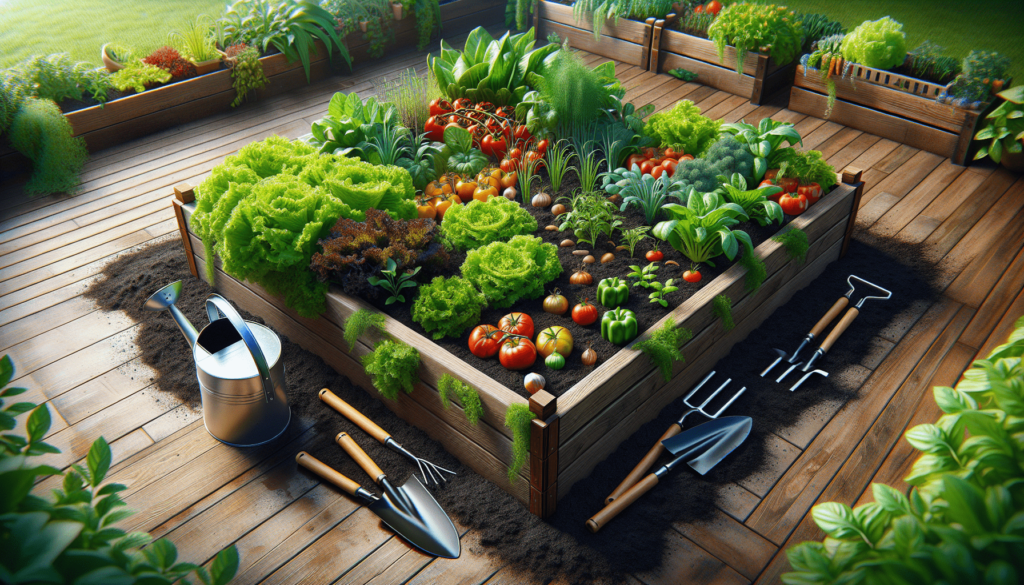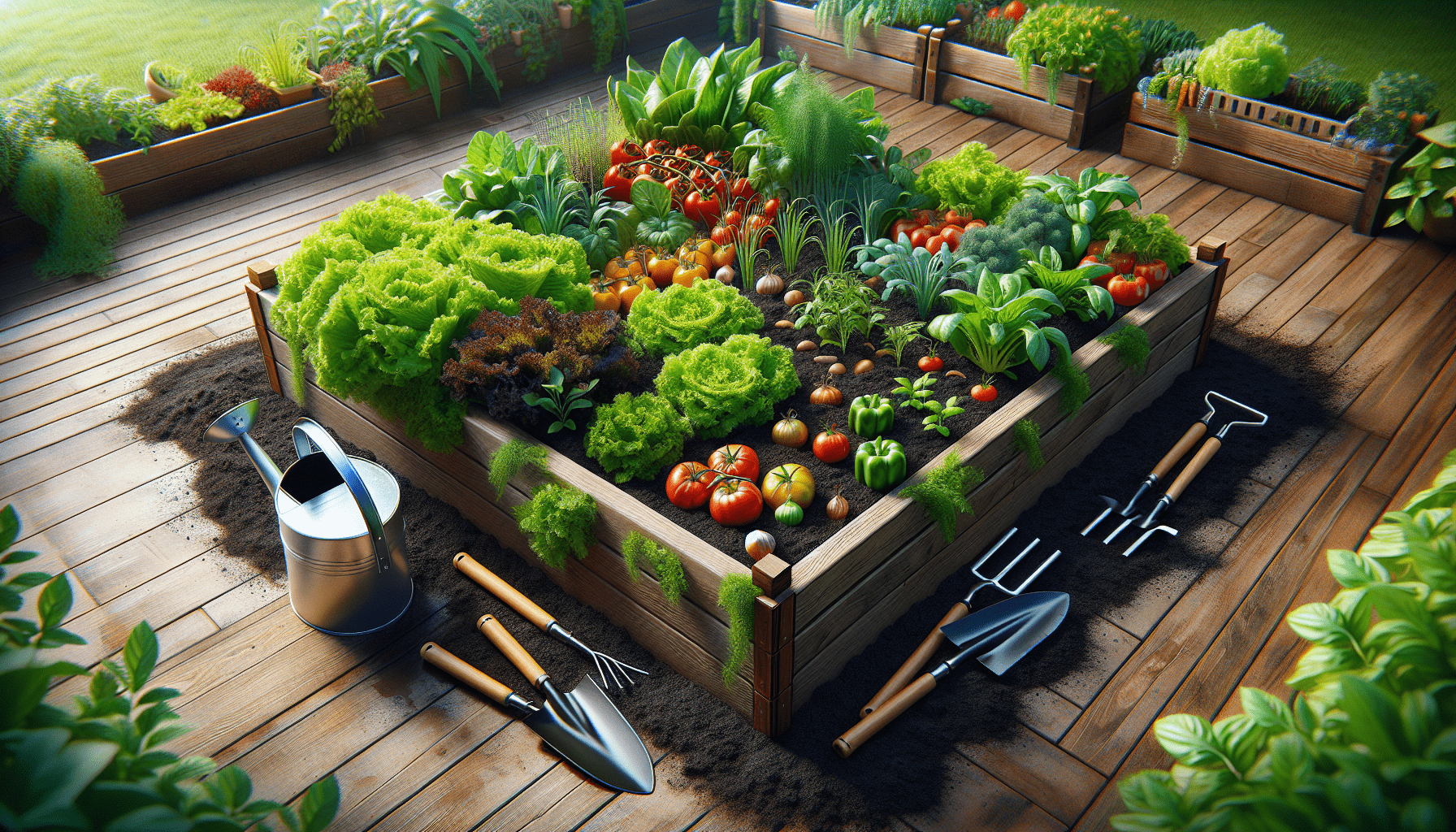Welcome to “Raised Bed Gardening Tips for Beginners.” Starting your journey into gardening with raised beds can be both rewarding and manageable. You’ll learn how to choose suitable materials, prepare the soil, and pick the right plants for your space. Setting up raised beds allows for better soil control and easier maintenance, making it ideal for both new and experienced gardeners. Let’s dive in and explore the basic steps you’ll need to create a thriving garden. Have you ever thought about starting your own garden but felt overwhelmed by the prospect? Don’t worry; you’re not alone. Raised bed gardening is an excellent way for beginners to dip their toes into gardening without getting bogged down by the traditional methods. This article will guide you through some essential tips and tricks for getting started with raised bed gardening.

Why Choose Raised Bed Gardening?
Raised bed gardening offers many advantages, making it an excellent choice for beginners and experienced gardeners alike. It allows you to have more control over your soil quality, improves drainage, and can even help keep pests at bay. Additionally, raised beds can be easier on your back and knees since you’re working at a higher level.
Benefits of Raised Bed Gardening
Improved Soil Quality
One of the key benefits of raised bed gardening is the ability to start with high-quality soil. You don’t have to deal with the compacted and nutrient-poor soil that may be in your yard. Instead, you can fill your raised bed with a custom blend of soil and compost that’s perfect for your plants.
Better Water Drainage
Issues with waterlogged soil? Raised beds typically offer superior drainage compared to in-ground gardens. This setup helps prevent problems like root rot and promotes a healthier growing environment for your plants.
Ease of Access
Raised beds can be built to a height that suits you, making gardening more comfortable and accessible. Whether you have mobility issues or just want to make gardening a little easier, raised beds can help you enjoy your hobby without strain.
Pest Control
Raised beds can also make it easier to control pests. Constructing barriers or using covers can more effectively protect your plants from unwanted visitors like deer, rabbits, and insects.
Getting Started with Raised Bed Gardening
Choosing the Right Location
Before you start building, you need to pick the ideal location for your raised bed. Look for a spot that gets at least six hours of sunlight daily. It should also be close to a water source so you can easily keep your plants hydrated.
Selecting Materials
Your choice of materials for constructing your raised bed can impact its durability and how it looks in your garden. Here are some options:
| Material | Pros | Cons |
|---|---|---|
| Wood | Natural look, easy to work with | May rot over time |
| Composite | Durable, rot-resistant | Can be expensive |
| Metal | Long-lasting, modern aesthetic | May get hot, potentially expensive |
| Stone/Brick | Very durable, attractive | Heavy, requires more effort to set up |
Building Your Raised Bed
Constructing your raised bed doesn’t have to be a complicated task. Here are some basic steps to get you started:
- Measure and Mark the Area: Measure your space and mark the perimeter of your raised bed with stakes and string.
- Prepare the Ground: Remove any grass or weeds from the area and level the ground.
- Assemble the Frame: Use your chosen materials to build the frame. Make sure it’s sturdy and level.
- Add a Base Layer: To improve drainage, consider adding a layer of gravel or broken ceramic pieces at the bottom.
- Fill with Soil: Add a mix of topsoil, compost, and other organic matter to create a nutrient-rich environment for your plants.
Choosing the Right Soil
The soil you use is critically important for the success of your raised bed garden. Aim for a well-balanced mix that provides plenty of nutrients while allowing for excellent drainage.
Soil Components
| Component | Purpose |
|---|---|
| Topsoil | Base material, holds structure |
| Compost | Adds nutrients |
| Peat Moss | Improves moisture retention |
| Perlite/Vermiculite | Enhances drainage |
Mix these components in a ratio of about 60% topsoil, 30% compost, and 10% perlite/vermiculite to create the ideal growing medium.
Selecting Plants for Your Raised Bed
Best Plants for Beginners
If you’re new to gardening, start with plants that are easy to grow and maintain. Here are some suggestions:
| Vegetable | Days to Harvest | Notes |
|---|---|---|
| Lettuce | 30-45 | Prefers cooler weather |
| Radishes | 22-30 | Fast-growing |
| Carrots | 70-80 | Needs deep soil |
| Tomatoes | 60-85 | Requires staking |
| Herbs (basil, parsley) | Varies | Easy to grow, great for cooking |
Companion Planting
Companion planting involves strategically planting different crops next to each other to enhance growth and deter pests. Here are some classic combinations:
| Plant Combination | Benefits |
|---|---|
| Tomatoes and Basil | Basil improves tomato flavor; deters pests |
| Carrots and Onions | Onions repel carrot flies |
| Lettuce and Radishes | Radishes can be harvested quickly, giving lettuce room to grow |
Watering Tips
Watering your raised bed garden correctly is crucial for healthy plants. Here are some guidelines to help you:
Frequency and Timing
Water your garden early in the morning. This allows the plants to absorb moisture before the heat of the day causes evaporation. Generally, your raised beds will need about 1 inch of water per week, but this can vary based on the type of plants and weather conditions.
Methods
- Hand Watering: Ideal for small raised beds. Use a watering can or hose with a delicate spray to avoid damaging plants.
- Soaker Hoses: These allow for even water distribution and are perfect for larger beds.
- Drip Irrigation: A more advanced method that conserves water by targeting the base of the plants.
Fertilizing Your Raised Bed
Even with high-quality soil, your plants will likely need additional nutrients as they grow. Here’s how to keep your garden thriving:
Types of Fertilizer
- Organic: Composted manure, fish emulsion, and seaweed extracts offer long-term benefits for your soil.
- Synthetic: Quick-release options can give your plants an immediate nutrient boost but may not improve soil health over time.
Application Tips
Follow the instructions on the fertilizer packaging for the best results. Generally, you’ll want to fertilize every couple of weeks during the growing season. Be careful not to over-fertilize, as this can harm your plants.
Controlling Pests and Weeds
Keeping your raised bed garden free from pests and weeds is vital for healthy plants.
Pest Control
Use barriers like row covers to protect your plants from insects. For larger pests, consider building a fence or using netting. Organic options like neem oil or insecticidal soap can also help manage insect issues.
Weed Management
Mulching is a great way to suppress weeds. Organic mulch like straw or wood chips not only keeps weeds at bay but also helps retain soil moisture. If weeds do pop up, remove them promptly to prevent them from taking over your garden.
Seasonal Maintenance
Your raised bed will require some upkeep throughout the year to remain productive and healthy.
Spring
- Preparation: Clean out any debris from the winter.
- Soil Testing: Test your soil and amend it as needed.
- Planting: Start planting cool-season crops like lettuce and radishes.
Summer
- Watering: Ensure consistent moisture levels.
- Weeding: Keep on top of weeds to prevent them from competing with your plants.
- Mulching: Apply mulch to conserve water and reduce weeds.
Fall
- Harvesting: Finish harvesting your summer crops.
- Soil Amendments: Add compost or other organic matter to replenish soil nutrients.
- Planting: Consider planting fall crops like kale and spinach.
Winter
- Cleanup: Remove dead plants and debris.
- Covering: Use cover crops or mulch to protect the soil over winter.
Troubleshooting Common Issues
Even the best gardeners face challenges. Here are some common problems and how to address them:
Poor Drainage
If your raised bed retains too much water, try adding more perlite or sand to improve drainage. Elevating the bed slightly can also help.
Nutrient Deficiencies
Yellowing leaves or stunted growth often indicate nutrient deficiencies. Conduct a soil test and amend accordingly, usually by adding compost or specific fertilizers.
Pests
If pests are an issue, identify the specific culprit before choosing a control method. Natural remedies are often less harmful than chemical pesticides and can keep your plant’s ecosystem balanced.
Disease
Keep an eye out for signs of disease, like spots on leaves or wilting. Removing affected plants promptly and using disease-resistant varieties can help keep your garden healthy.
By following these tips, you’ll be well on your way to creating a thriving raised bed garden. Remember, gardening is a learning process, and a big part of the enjoyment comes from learning and seeing your plants grow. So take these tips, roll up your sleeves, and get started on your gardening adventure!


